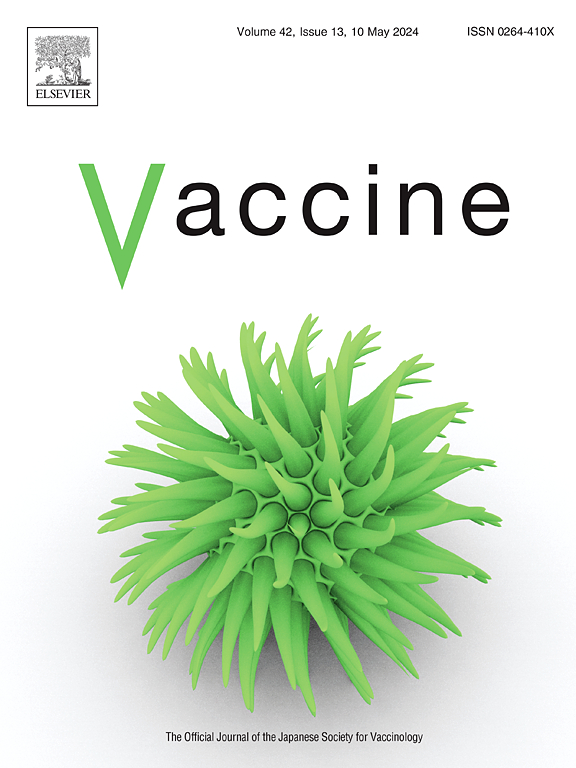Time intervals from vaccine administration to reimbursement for an updated Advisory Committee on Immunization Practices (ACIP) recommendation: Evidence from pneumococcal conjugate vaccinations among privately insured adults, 2021–2022
IF 4.5
3区 医学
Q2 IMMUNOLOGY
引用次数: 0
Abstract
Background
Vaccination implementation challenges can lead to lower uptake, reducing health and economic benefits from vaccines. Healthcare provider confidence in receiving timely reimbursement for vaccination is one such potential challenge for newly recommended vaccines. This study investigates the time interval between pneumococcal vaccination and reimbursement.
Methods
We used 2021–2022 Merative™ MarketScan® Commercial Database and Medicare Database (MarketScan) data among those aged 19–64 and ≥65 years for two vaccines: the 13-valent pneumococcal conjugate vaccine (PCV13), recommended in 2012; and the newer 20-valent PCV (PCV20), recommended in 2021. We characterized vaccination claims, patient demographics, and time intervals between vaccination and reimbursement.
Results
During the study period, MarketScan® contained 24,508 PCV13 and 53,194 PCV20 outpatient vaccination claims for individuals aged 19–64 years and 14,693 PCV13 and 18,277 PCV20 claims for those aged ≥65 years. Among those aged 19–64 years, mean reimbursement interval of outpatient claims was 25.3 (PCV13) and 26.8 (PCV20) days. Among those aged ≥65 years, mean interval was longer, particularly for PCV20, with 31.5 (PCV13) and 41.3 days (PCV20). Outpatient claims reimbursement intervals were longer in non-metropolitan compared to metropolitan areas. Pharmacy claims had shorter intervals than outpatient claims, across both vaccines and age groups. PCV13 intervals were similar throughout the observation period, while PCV20 intervals were longer immediately following the updated ACIP recommendation and declined over time. Approximately 10 % of outpatient claims had intervals greater than 30 days among those aged 19–64 years and greater than 60 days for those aged ≥65 years.
Conclusion
During the 5 months following the ACIP recommendation, claims for the newer vaccine (PCV20) took longer to reimburse, but the interval stabilized after about 6 months to a length comparable to PCV13. Claims from outpatient settings and non-metropolitan areas took longer to reimburse, with some claims still experiencing longer intervals several months post-recommendation.
更新的免疫实践咨询委员会(ACIP)建议从接种疫苗到报销的时间间隔:2021-2022年私人参保成人肺炎球菌结合疫苗的证据
疫苗接种实施方面的挑战可能导致接种率下降,从而降低疫苗带来的健康和经济效益。对于新推荐的疫苗,医疗保健提供者对及时收到疫苗报销的信心是一个潜在的挑战。本研究探讨肺炎球菌疫苗接种与报销之间的时间间隔。方法:我们使用2021-2022年Merative™MarketScan®商业数据库和Medicare数据库(MarketScan)数据,在19-64岁和≥65岁的人群中接种两种疫苗:2012年推荐的13价肺炎球菌结合疫苗(PCV13);以及2021年推荐的较新的20价PCV (PCV20)。我们描述了疫苗接种要求、患者人口统计学特征以及疫苗接种和报销之间的时间间隔。结果在研究期间,MarketScan®包含19-64岁人群的24,508个PCV13和53194个PCV20门诊疫苗申报单,以及≥65岁人群的14,693个PCV13和18,277个PCV20申报单。19 ~ 64岁患者的平均报销间隔分别为25.3天(PCV13)和26.8天(PCV20)。在≥65岁的人群中,平均间隔时间更长,特别是PCV20,为31.5天(PCV13)和41.3天(PCV20)。与大都市地区相比,非大都市地区的门诊索赔报销间隔更长。无论是疫苗还是年龄组,药房索赔的间隔时间都比门诊索赔短。在整个观察期间,PCV13间隔时间相似,而在更新ACIP建议后,PCV20间隔时间较长,并随着时间的推移而下降。在19-64岁的人群中,大约10%的门诊索赔间隔大于30天,≥65岁的人群中间隔大于60天。在ACIP推荐后的5个月内,新疫苗(PCV20)的报销时间较长,但在约6个月后稳定至与PCV13相当的时间间隔。来自门诊和非大都市地区的索赔需要更长的时间来报销,一些索赔在推荐后几个月仍然需要更长的时间间隔。
本文章由计算机程序翻译,如有差异,请以英文原文为准。
求助全文
约1分钟内获得全文
求助全文
来源期刊

Vaccine
医学-免疫学
CiteScore
8.70
自引率
5.50%
发文量
992
审稿时长
131 days
期刊介绍:
Vaccine is unique in publishing the highest quality science across all disciplines relevant to the field of vaccinology - all original article submissions across basic and clinical research, vaccine manufacturing, history, public policy, behavioral science and ethics, social sciences, safety, and many other related areas are welcomed. The submission categories as given in the Guide for Authors indicate where we receive the most papers. Papers outside these major areas are also welcome and authors are encouraged to contact us with specific questions.
 求助内容:
求助内容: 应助结果提醒方式:
应助结果提醒方式:


